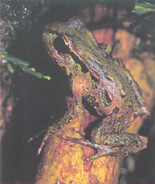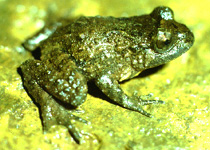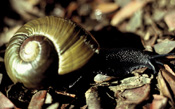
Plan to pull big snail from brink
"They are the sumo wrestlers of the snail world, as big as a man's fist and able to
out-slide then suck up unsuspecting slugs and worms like humans eat spaghetti"
New Zealand Herald
22 January 2004
Endangered frogs to be given powhiri
"About 50 endangered native Archeys frogs from Te Kuiti are to be given a
powhiri at Canterbury University"
New Zealand Herald
30 July 2002
Lethal fungus disaster for unique NZ frog
"An international biological treasure is at risk of extinction ...
People moving through native frog habitats are thought to be spreading a fungus"
New Zealand Herald
8 November 2001 |
|
Photo Credit
Upper right:
Archey's frog;
Left top: Tuatara, male,
Poor Knights Island,
Rod Morris 1985;
Left second from top:
Kakapo;
Left third from top:
Tusked weta;
Bottom center:
Hochstetter's frog;
Bottom far right:
Kauri snail, Warkworth,
Rod Morris 1980.
Crown Copyright,
Department of Conservation
Illustration Credit:
Left third from top:
John Gerrard Keulemans
1842-1912, Huia (male
and female) Heteralocha
acutirostris 1888.
Left fourth from top:
Large kauri
Permission of the Alexander Turnbull Library, National Library of New Zealand,
Te Puna Matauranga o Aotearoa must be obtained before any reuse of these images. |
|
 |
| |
Land animals of the Jurassic period which were dominated by insects, amphibians and reptiles, made their way to New Zealand before the land broke away from Gondwanaland 80 million years ago. New Zealand's only four species of native frog have lived through geological ages, and still survive today. They are all endemic to New Zealand, and are 'living fossils' because they are surviving members of primitive animal groups of the late Palaeozoic and early Mesozoic period.
 See more on living fossils at gigantism in insects and tuatara. See more on living fossils at gigantism in insects and tuatara. |
| |
| |
|
Hamilton's frog
Leiopelma hamiltoni
Maud Island frog
L. pakeka
Hochstetter's frog
L. hochstetteri
Archey's frog
L. archeyi (right)
Prehistoric Hamilton's, Hochstetter's and Archey's frogs of the genus
Leiopelma are the most ancient and the most primitive frogs in the world.
Four species are only found in New Zealand, and are 'living fossils',
very similar to frogs in fossils found in Queensland, Australia from the late
Jurassic 150 million years ago.
A rare feature of Hamilton's and Archey's frogs is that they have no webbing
between their toes. They occupy a broad range of forest environments without
being tied to the water habitat of lakes, ponds or streams. Hochstetter's frog has
partial toe webbing and can be found in stream margins.
New Zealand native frogs are unique because they do not go through a tadpole stage,
but instead develop totally within a gelatinous capsule derived from an egg. The
father cares for the infant in three of the species. Male Archey's frogs carry
infants on their back.
A primitive feature retained by Leiopelma frogs is their tail-wagging
muscles, that no longer have a tail to wag. They do not croak as a normal
frog, but instead let out a thin high pitched squeak, because eardrums or
vocal sacs have never developed. |
|

Research on fungus fatal for frogs .....
Fifty threatened Archey's frogs from the Whareorino Forest near Te Kuiti are being
studied at the University of Canterbury, to find out why they are dying from a fungus. An alarming number of dead frogs were found in Te Kuiti and Coromandel forests during 2002. As dead frogs very quickly decompose, it is a matter of concern when a number of them are found.
Frog populations have been falling worldwide since the 1980s. The chytrid fungus which was first identified in Australia and South America in 1998, and New Zealand in 1999, is the suspected cause. It infects the skin of amphibians, restricting their breathing and water intake.
|
|
| |
|
Native frogs are hard to find because they are nocturnal, very well camouflaged and very small. Archey's is the smallest, just 37 mm long and no bigger than a golf ball. Hochstetter's frog is the largest of the four species, measuring up to 48mm in length. New Zealand's native frogs are distinguishable from normal frogs by round pupils.
Fossil records show that New Zealand had seven frog species 1000 to 2000 years ago. Hochstetter's frog (below) is more widespread at locations throughout the northern half of the North Island. Archey's is restricted to the Coromandel Peninsula, and one site near Te Kuiti in the central North Island, where they were discovered a few years ago. |
| |
 |
Frogs on Stephen's Island and Maud Island in the Cook Strait were previously thought to be the same species of Hamilton's frog Leiopelma hamiltoni.
It was discovered from genetic research in 1998 that the frogs on Maud Island were an obscure, distinct species, which were given the new name Leiopelma pakeka. |
| |
| |
There is limited difference in form, but the two species are
distinctively different genetically. Leopelma hamiltoni
is closer genetically to Leopelma archeyi, however, these species differ
morphologically. The identification of Leopelma pakeka increases the
conservation significance of Hamilton's frog, which is one of the world's rarest frogs.
Fossils records show that Leopelma hamiltoni was once widespread from the
Waikato region in the North Island to Punakaiki on the West Coast of the South Island.
Today there are only about 300 remaining.
Next page on living fossils - Tuatara > |
|

International Threatened
and Endangered Listings
2006 IUCN Red List of
Threatened Species
Archey's frog
Leiopelma archeyi
Critically endangered
Hamilton's frog
Leiopelma hamiltoni
Endangered
Maud Island frog (Pakeka)
Leiopelma pakeka
Vulnerable
Hochstetter's frog
Leiopelma hochstetteri
Leiopelma pakeka n.sp.
Vulnerable
Kauri snail
Paryphanta busbyi
Lower risk, near threatened
Kauri snail
Paryphanta traversi
Paryphanta rossiana
Paryphanta lignaria
Paryphanta hochstetteri
Paryphanta gilliesi
Data deficient
Flax Snail (Pupuharakeke)
Placostylus hongii
Vulnerable
Flax snail
Placostylus bolonsi
Vulnerable
Flax snail
Placostylus ambagiosus
Vulnerable
Tuatara
Sphenodon guntheri
Vulnerable
United States Threatened and Endangered Species, Foreign Listed Species
Hamilton's frog
Leiopelma hamiltoni
Endangered
Tuatara
Sphenodon guntheri
Endangered
Brothers Island Tuatara
Sphenodon guntheri
Endangered
Kauri snail
Paryphanta busbyi
Flax snail (Pupuharakeke)
Placostylus hongii
New Zealand's giant land snails also show signs of Gondwana heritage,
probably arriving on New Zealand at about the same time as the native frogs and tuatara.

Paryphanta and Placostylus snails have coiled shells up to
115 centimeters (4.5 inches) in diameter. They belong to the oldest land snail family
that originated 200 to 300 million years ago in the late Palaeozoic or early Mesozoic.
New Zealand's land snails have remained the same in isolation, whereas ancestral
lineages in other regions gave way to the European snail Helix aspersa.
Land snails were once wide-spread in the Northland
region, but have suffered from habitat depletion and predation by introduced
animals. The Kauri snail may live more than twenty years, as shown by
a study that marked adult snails in 1979, and found them again in 1992.
Kauri snails are carnivorous, eating earthworms, insects, and insect lavae.
They are also cannibals, eating other snails. |
|


